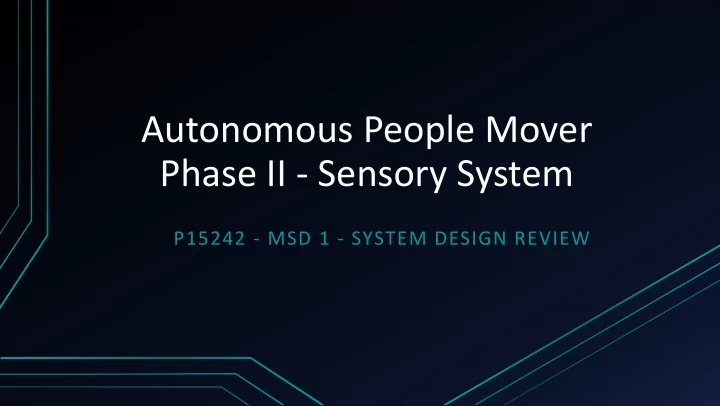

Autonomous People Mover Phase II - Sensory System P15242 - MSD 1 - SYSTEM DESIGN REVIEW
Member Role Program The Team Nathan Biviano Project Manager & IE Integration Madeleine Software & CE Daigneau Communication James Danko Controls & EE Communication Connor Goss Software & CE Communication Austin Hintz Power & Electrical EE Design Sam Kuhr Power & Electrical EE Design Benjamin Tarloff Controls & ME Integration
Agenda ● Background ○ Project Background ○ Team Overlap ○ Scope ○ Customer Requirements ○ Engineering Requirements ○ Risk Assessment ● System Analysis ○ HOQ Relationship Diagram ○ Functional Decomposition ○ Engineering Analysis ○ Concept Selection/System Level Proposal ○ Test Plan ○ Updated Schedule
Feedback Topics ● Sensor Selection ● Microcontroller Selection ● Sub-microcontrollers ● Sensor Layout ● Sensor Integration Difficulty
Project Background The Rochester Institute of Technology wishes to re-enter the field of research in vehicle autonomy. Autonomy is becoming more and more important as automotive standards leave fewer vehicle functions to the human user. Autonomous vehicles offer significant improvements in roadway safety and traffic flow. The base of this project is the work started by the Autonomous People Mover Phase I team.
Team Overlap & Integration
Project Scope Phase I Phase II Phase III+ ● ● ● Remote Control Autonomous Forward Full Autonomy (forward ● Manual Override Drive & reverse) ● ● Static Object Refined User Interface ● Detection & Object Identification & Avoidance Avoidance ● ● Closed Course Static & Dynamic Objects ● Remote and Manual Override
Customer Requirements
Engineering Requirements
Risk Assessment
HOQ
Functional Decomposition
Autonomous Mode
Vehicle Benchmarking
LIDAR Benchmarking
Morph Chart
Morph Chart
Engineering Analysis of Sensor Placement
Engineering Analysis of Sensor Placement
Engineering Analysis of Sight
Engineering Analysis of Sight
System Overview
Concept Selection Process
Concept Selection Process
Concept Selection Process
Concept Selection
Engineering Analysis ● Will we have sufficient forward sight on the cart? o Yes ● Microcontrollers - # of Inputs? Processing? o Sub-microcontrollers ● Sensors - Amount of certain types? Orientation? ● Power Consumption* *No specifications for some sensors so competitor data was used.
Sensor Analysis Sensor Communication Number of Inputs Ultrasonic Analog-Digital 6 Converter LIDAR Ethernet/USB 1 RADAR CAN 3 Camera USB 2.0 2 GPS Serial 1 Accelerometer I2C 1
Microcontroller Benchmarking
Microcontroller Benchmarking
ROS vs. PolySync ROS with SLAM PolySync ● Optimized for Robotic Systems ● Optimized for Autonomous Vehicle Image Integration Stitching ● Simultaneous Localization and ● Algorithms for diagnostics, automatic fault Mapping (SLAM) recovery and cybersecurity ● 3D Perception ● Integrated Simulation ● Works well with Autonomous ● Advanced Logging and Replay Navigation ● Plug and Play with massive ecosystems of ● Much Existing Code sensors, actuators, and computer ● Adaptable to most systems hardware ros.org harbrick.com
Test Plan Once we have agreed upon sensors, ordered and received them: ● Write test code ● Test the different types of sensors under a variety of conditions ● Test different software to see which is the most versatile and user friendly ● Verify sensors are working ● Test sensor code Translate sensor output data into a useful diagram o ● Revise code as needed
Schedule
Questions? Feedback?
Recommend
More recommend